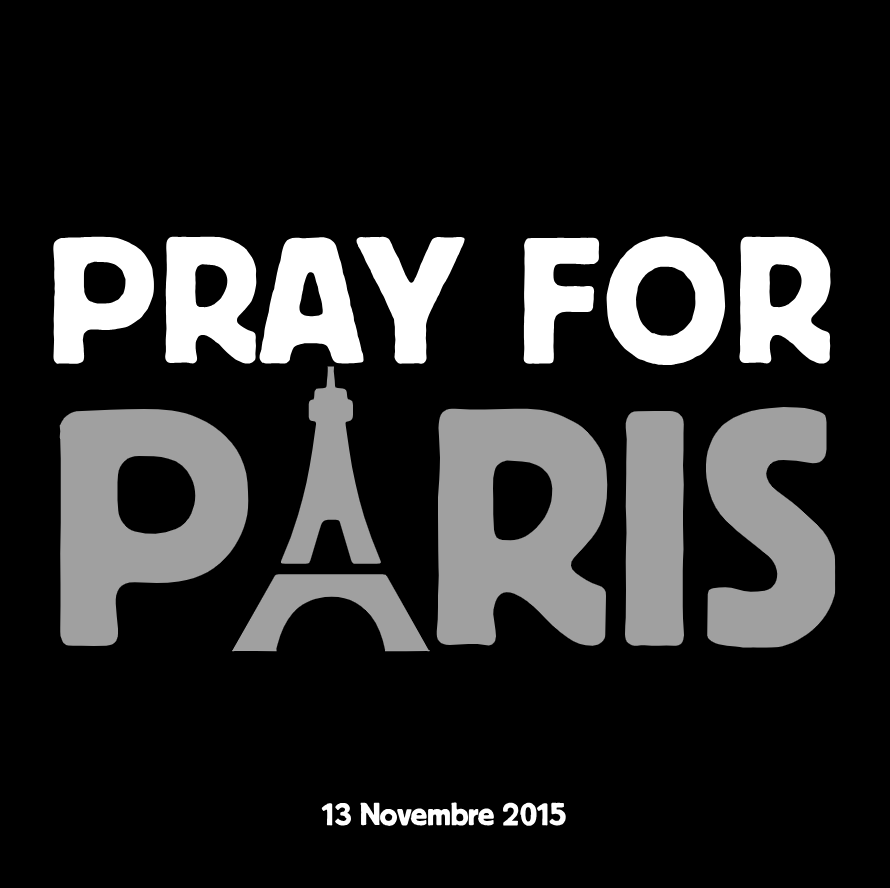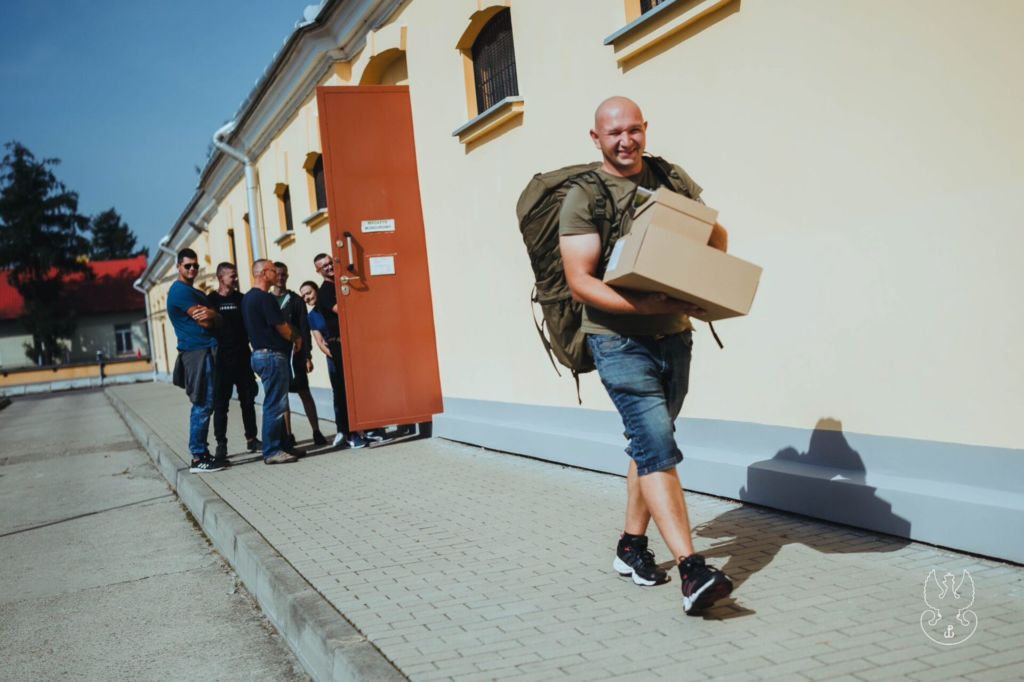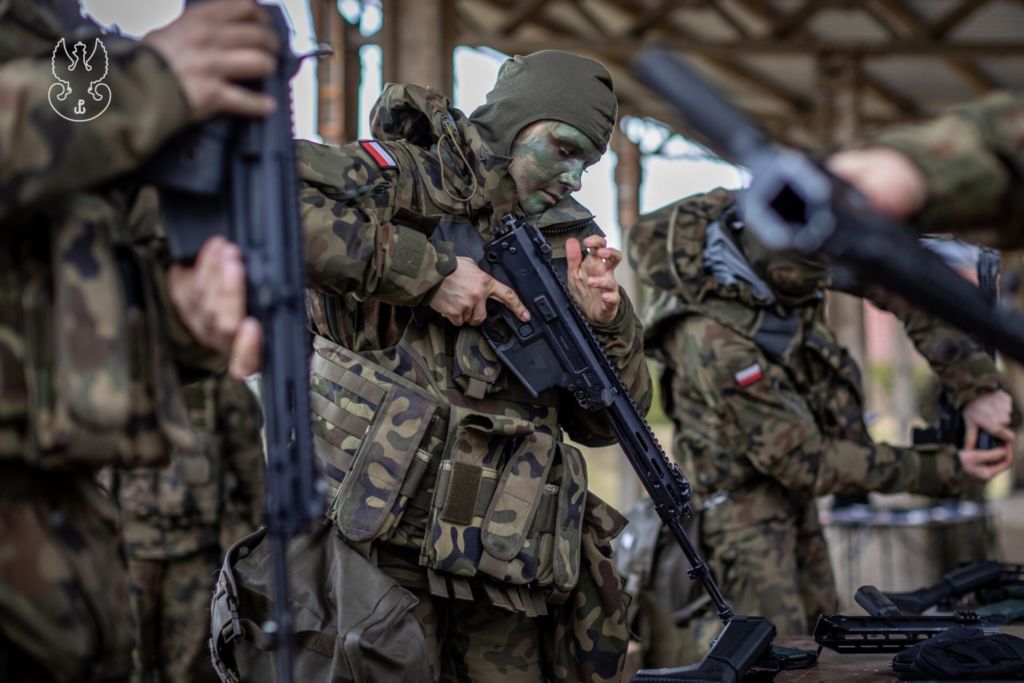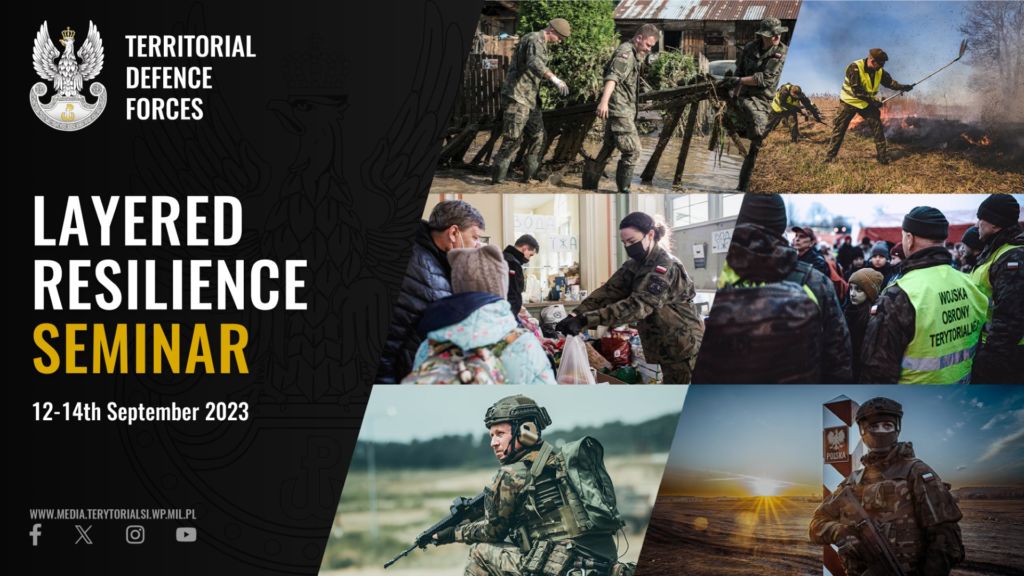Polish-Style Territorial Defense Could Be the Answer to the Risk of Civil War in France
Posted By Olivier Bault On In North American New Right | Comments Disabled2,588 words
If a civil war breaks out, the French native population will be somewhat defenseless, even if they are (still) a majority. The country’s armed forces have been shrinking in size over the years, down to a little over 200,000 military personnel in total in 2023. Creating a territorial defense force like the one that has been set up in Poland recently would be a much better solution.
France’s six nights of chaos [2] in late June and early July this year were observed with bewilderment in neighboring countries. The shooting of a young thug of Algerian origin set the country’s immigrant suburbs on fire, and the flames of anger soon spread to the centers of big cities as well as to smaller cities and towns across the country. Pierre Brochand, a former head of France’s intelligence service, said he estimated the number of rioters [3] — mostly young men of Arab and African origin, as could be seen on videos circulating on social media — at somewhere between 100,000 and 200,000. Compared to the previous country-wide wave of rioting spilling out from France’s crime-ridden no-go zones in 2005, this time there were more rioters, they had much better coordination (thanks to social media), the city centers and the smaller cities no longer appeared safe, and above all, those in charge of law enforcement feared they could lose control of the situation, especially if the young rioters started using automatic weapons instead of fireworks, stones, and Molotov cocktails.
The claim that France is at risk of being plunged into anarchy — and maybe even full-fledged civil war — has been made by several high-ranking officers and political leaders in recent years.
While the riots were still continuing, on July 2 Gendarmerie Colonel Philippe Cholous said on CNews television:
The level of irritation and resentment, the level of violence, and above all the fact that in some areas there is real hatred of France and weapons circulating: All this makes the situation potentially explosive. And just because fewer vehicles are being set on fire or fewer stores are being looted doesn’t mean the potential risk is diminishing.
In a book published as early as 2016, Gendarmerie General Bertrand Soubelet had given this sinister warning:
The suburbs of our big cities, where too many young people are left to their own devices and are often poorly educated, sometimes dropping out of school, and who have no prospects for the future are reservoirs of rebels. It is in that pool of rebellious, misguided children who have lost their way and are in need of guidance that jihad does its business. We are living on a powder keg because those delinquents, those potential killers, have an almost inexhaustible source of instruments of death: In the large urban areas of France, there are stocks of illicit weapons which are the remnants of the wars in Central Europe [the Balkans]. What frightens us, the gendarmes, is that those stocks of weapons, which are lying dormant at the moment, will one day get into the hands of determined and organized people.
Soubelet had held various command positions in the field and then at the Directorate General of the National Gendarmerie, so he was in a good position to know what he was talking about. Unfortunately, that book put an end to his career.
In 2020, three years after he had resigned as Chief of Staff of the French Armed Forces, General Pierre de Villiers said in an interview [4] in the French daily Le Parisien that he feared France “could fall slowly or very rapidly” into a “civil war” that could be ignited by “a spark like in 1789,” and that France had become a country where “a teacher gets beheaded in front of a middle school and three persons are assassinated while praying in a church,” with many “20-year-olds who hate France, and who are close to the local kingpins or the Salafists.”
In 2021, in an “open letter to our political rulers,” hundreds of retired military officers, including 26 generals and an admiral, warned the French political class [5] of the risk of a civil war in France, as in their view (and not only theirs) French society is undergoing a process of rapid disintegration. In another open letter published a few weeks later by active military officers to express their support for their elders who were stuck in the crossfire of critics from the mainstream media and faced with sanctions from the government, it is stated [6]:
In Afghanistan, Mali, Central Africa, and elsewhere, a number of us have come under enemy fire. Some have lost comrades. They gave their lives to destroy the Islamism you are making concessions to on our soil. Almost all of us have experienced Operation Sentinelle [the military operation involving 10,000 soldiers and thousands more police officers and gendarmes who were deployed to secure “sensitive points” after the wave of deadly Islamic terrorist attacks in 2015–Ed.]. We have seen for ourselves the abandoned suburbs, the accommodations made for crime. We have endured the attempts at instrumentalization by several religious communities, for whom France means nothing — nothing more than an object of sarcasm, contempt, and even hatred.
“If we do nothing or if we do little, we are going to head either towards a progressive implosion of social trust in France — that is to say, towards a society where the quality of life will collapse and where it will be less and less pleasant to live — or, through successive explosions, towards confrontations that will make France a country where one will not be able to live at all,” the man who was head of French counter-intelligence in 2002–2008 warned in a radio discussion [7] last April.
This is not to mention several books by respected commentators containing warnings against the looming civil war, such as The Civil War That Is Coming (La guerre civile qui vient), written by Le Figaro’s long-time journalist and columnist Ivan Rioufol, and published in 2016.
There are also statements by top politicians, such as President Macron himself, who, reacting to columnist and essayist Éric Zemmour’s 2019 comment about the existence of a Molotov–Ribbentrop pact between liberals and Islamists against French white Catholic heterosexuals, warned that in today’s France [4] one has to watch one’s mouth as such “confusion between the issues of immigration, radicalization, communitarianism, and laicity” could very well spark a civil war. His predecessor, François Hollande, had remarked to journalists in 2016 [8] about the country he had already been ruling for four years: “How can we avoid partition? Because that is what is happening: partition.”
 [9]
[9]Logotype derived from the Je suis Charlie (I am Charlie) logo — graphic adaptation of the #PrayforParis hashtag shared by Internet users around the world in support of the Parisians after the bloody attacks by Islamic terrorists in Paris in November 2015 (Vectorized by O.ParkerFont: Block Berthold Regular, Public domain, via Wikimedia Commons).
And there is, of course, the stark warning by Interior Minister Gérard Collomb, a pro-immigration Socialist such as Hollande, and such as Macron when the latter was a member of Hollande’s government. When he resigned in 2018, Collomb lamented that “the French are living side by side,” but could soon “live face to face.” A few months before his resignation, France’s then-Interior Minister had told journalists:
What I read every morning in police reports reflects a very pessimistic situation. Relations between people are very harsh, people don’t want to live together . . . communities in France fight against one another, and it’s becoming very violent.
 [10]
[10]You can buy Alain de Benoist’s Ernst Jünger between the Gods and the Titans here [11].
It is telling that in bestselling author Laurent Obertone’s book Guerilla — The Day Everything Went Up in Flames (Guérilla — Le jour où tout s’embrasa) — which describes events very reminiscent of what happened a few months ago in France, but where things do get out of control, engulfing France in a full-fledged civil war after three days of a descent into chaos — the army is not sent in to restore order. The French army has a large proportion of soldiers from immigrant backgrounds in its ranks, and in Obertone’s book, which claims to have been written “based on the listening, detection, and forecasting work of French intelligence,” there are fears that those soldiers — or some of them, at least — might take sides with the hordes that come from the same suburbs and “sensitive districts,” as they do.
If a civil war breaks out, the French native population will be somewhat defenseless, even if they are (still) a majority. The country’s armed forces have been shrinking in size over the years, down to a total of a little over 200,000 military personnel in 2023 (including over 60,000 reservists). At the turn of the century, President Jacques Chirac abolished compulsory military service for all Frenchmen born after 1979. This means that most law-abiding citizens in France who were born after that year have never held a weapon in their hands and would not even know how to use a firearm. It would be difficult to reestablish compulsory military service today, and anyway it would mean training all French citizens — including those who hate France, do not consider themselves French, and who might later pledge allegiance to some kind of Islamic State (or perhaps already have).
Creating a territorial defense force such as the one that has been set up in Poland recently would be a much better solution. It would mean training and arming volunteers only — that is, people with a sense of patriotism, and the French authorities could very well exclude from that scheme the country’s internal enemies from the “sensitive districts” by making acceptance conditional on having no police or judicial record, and not being “fiché S” — that is, not being recorded by the police as presenting a potential danger to public safety.
 [12]
[12]Future Subcarpathian members of the Polish Territorial Defense Force setting off for their first military drill (source: https://twitter.com/terytorialsi [13]).
Certainly, it is not for the same reason that the Poles created their own territorial defense force in 2017. Like its Central European neighbors, which have not yet gone fully multicultural in the fashion of Western Europe, Poland is a safe country, with much less crime and fewer rapes, and with no mass rioting of the type seen in France two months ago. When Poles talk of a civil war in their country, they are referring to the heated political debate and not to the risk of a real civil war.
 [14]
[14]You can buy Charles Krafft’s An Artist of the Right here [15].
In Poland, compulsory military service for all young men was suspended in 2008, and has remained so since then.
After the conservative Right won the elections in 2015, however, it was decided to create a Territorial Defense Force to face the danger of a “hybrid” or proxy war such as the one Russia had been waging in eastern Ukraine since 2014. This force was also meant to become a partisan army in the rear of an invading Russian army when it was believed the latter’s capacity made a rapid retreat of the Polish regular army likely in the event of an invasion — before there could even be a reaction from its NATO partners. (Remember that until 2016, there were no NATO troops stationed in Poland or the Baltic states, and hardly any elsewhere on the Alliance’s eastern flank.) Poland’s Territorial Defense Force has also proved very useful in times of natural disasters, and in the face of Alexander Lukashenko’s assault on the Polish border [16] with the migrants he has been bringing in from the Middle East and Africa.
As of today, Poland’s territorial defense has some 36,000 troops, forming light infantry battalions initially concentrated in the eastern part of the country (close to the source of the perceived threat), but increasingly spread throughout Poland’s territory as they grow in size. Their role is to:
-
conduct defensive operations in cooperation with regular troops and in support of civilian organs;
-
conduct independent unconventional, counterinsurgency, and counter-deployment operations;
-
participate in securing the reception and deployment of allied reinforcement forces in their areas of action;
-
act in the field of crisis management, combatting natural disasters and eliminating their consequences, providing protection of property, and conducting search and rescue operations;
-
conduct information-gathering activities.
The members of the Territorial Defense Force are all volunteers who enlist for a (modestly) paid rotational military service, which they combine with their civilian lives. They sign up for a period of one to six years, which can be renewed. Active service in the Polish Territorial Defense Force starts with 16 days of training for those with no military experience, or eight days for army reservists. They then have rotational training for two days each month, always during weekends, with an additional integrated training of 14 days each year. The military training takes place close to where members of the force live, allowing people to join the armed forces without having to give up their civilian lives. The Territorial Defense Force in Poland is indeed one of the five branches of the Polish Armed Forces (the others being the Land Forces, the Air Force, the Navy, and the Special Forces), in a country that now spends the equivalent of 3% of its Gross Domestic Product (GDP) on its defense, way above the NATO-imposed minimum commitment of 2% of GDP. By comparison, France spends only 1.8% of its GDP on defense, and thus remains below NATO’s 2% threshold.
 [18]
[18]Tactical drills during the basic training of the Braniewo Territorials belonging to the 4th Warmian-Masurian Territorial Defense Brigade battalion. Braniewo, March 14, 2023 (Photo: DWOT, https://media.terytorialsi.wp.mil.pl/ [19]).
When this new component of the Armed Forces was initially created a few years ago, it was debated whether its members should be allowed to keep their weapons at home, as in the Swiss army, or whether those weapons should be kept in an array of safe locations from where they could be swiftly distributed in case of need. The second option was chosen, as the general principle in Poland is that law-abiding citizens should have limited access to firearms (just as in France). But this could be changed rapidly in case of necessity.
The general idea behind the creation of a Territorial Defense Force in Poland was to make the country more resilient, thus acting as an additional deterrent to a potential aggressor (Russia). A French territorial defense force of this kind would surely hugely improve the resilience of French society as a whole. Just like the Polish territorial force, it would be a powerful deterrent against those who might want to go further than just use fireworks, stones, and Molotov cocktails to spread mayhem in French towns and cities and to reach for the “stocks of illicit weapons” in the suburbs which are so much a cause of concern to the gendarmes. It could also prove very useful to alleviate France’s overstretched military in securing the thousands of civilian “sensitive points” across France. Like compulsory military service once did, a French Territorial Defense Force would have a positive effect on reunifying a divided society by gathering together people with diverse backgrounds, including immigrant backgrounds, but having in common their love for France. And it would be a civilized, democratic alternative to the temptation some young French patriots might have to do something on their own to try and save their country. It is not clear that there are many such patriots ready to act in such a way, but the danger of the “far Right” is constantly brandished by Macron’s government, and in particular by his Interior Minister, Gérald Darmanin. So why not channel the desire of some French people to defend and perhaps even save their country by creating a Territorial Defense Force as Poland has done?
This article [20] was originally published at the English-language Polish conservative site Sovereignty.pl [21].

